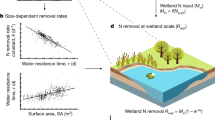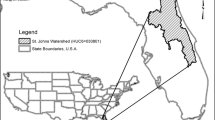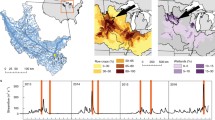Abstract
Wetlands, in Sweden and elsewhere, have been suggestedas effective and low-cost sinks for agriculturalpollution. This paper estimates the value of usingwetlands for abatement of agricultural nitrogen loadon the Baltic Sea. A replacement value of wetlands isestimated for Sweden. The replacement value is definedand estimated as the difference between twocost-effective reductions of agricultural nitrogenpollution: one that uses wetlands for nitrogenabatement, and one that does not. It is shown that theuse of wetlands as nitrogen sinks can reduce the totalabatement costs of nitrogen emissions by 30% forSwedish agricultural sources of nitrogen pollution.
Similar content being viewed by others
References
Arheimer, B. and H. B. Wittgren (1994), ‘Modeling the Effects of Wetlands on Regional Nitrogen Transport’, Ambio 23(6), 378-386.
Baumol, W. J. and W. E. Oates (1988), The Theory of Environmental Policy. New York: Cambridge University Press.
Brooke, A., D. Kendrick and A. Meeraus (1992), GAMS. A User's Guide. San Fransisco: The Scientific Press.
Bergstrom, J. C. and J. R. Stoll (1993), ‘Value Estimator Models for Wetlands-Based Recreational Use Values’, Land Economics 69(2), 132-137.
Byström, O. (1996), Costs and Values of Wetlands for Nitrogen Abatement in Sweden. Dissertations, 26. Uppsala, Sweden: Dept of Economics, Swedish University of Agricultural Sciences.
Byström, O. (1998), ‘The Nitrogen Abatement Cost in Wetlands’, Ecological Economics(forthcoming).
D'Angelo, E. M. and K. R. Reddy (1994), ‘Diagenesis of Organic Matter in a Wetland Receiving Hypereutrophic Lake Water. II. Role of Inorganic Electron Acceptors in Nutrient Release’, J. Environ. Qual. 23(5), 937-943.
Elofsson, K. (1993), Kostnader för att minska kväve-och fosforutsläpp i Höganäs kommun. Fakta Trädgård, Nr. 1092. Alnarp: Swedish University of Agricultural Sciences.
Elofsson, K. (1997), Cost-Effective Abatement in the Agricultural Load of Nitrogen to the Baltic Sea. Dissertations, 28. Uppsala, Sweden: Dept of Economics, Swedish University of Agricultural Sciences.
Fleischer, S., I. M. Andreasson, G. Holmgren, A. Joelsson, T. Kindt, L. Rydberg and L. Stibe (1989), Land Use Water Quality. Meddelande 1989: 10. Halmstad, Sweden: Länsstyrelsen.
Folke, C. (1990). Evaluation of Ecosystem Life-Wupport in Relation to Salmon and Wetland Exploitation. Dissertations. Stockholm: Dept of Systems Ecology, University of Stockholm.
Gren, I. M. (1993), ‘Alternative Nitrogen Reduction Policies in the Mälar Region, Sweden’, Ecological Economics 7(2), 159-172.
Gren, I. M. (1995), ‘The Value of Investing in Wetlands for Nitrogen Abatement’, European Review of Agricultural Economics 22(2), 157-172.
Gren, I. M. and T. Söderqvist (1994), Economic Valuation of Wetlands: A Survey. Beijer Discussion Paper Series No 54. Stockholm: Beijer Institute of Ecological Economics.
Griffin, R. C. and D. W. Bromley (1982), ‘Agricultural Runoff as a Nonpoint Externality: A Theoretical Development’, American Journal of Agricultural Economics 64(3), 547-552.
Hammar, O. (1990), Växtodling 2, Växterna. Stockholm: Lts Förlag.
Heimlich, R. E. (1994), ‘Costs of an Agricultural Wetland Reserve’, Land Economics 70(2), 234-246.
HELCOM (1993), The Baltic Sea Joint Comprehensive Environmental Action Programme. Helsinki: Baltic Sea Environmental Proceedings, No. 48.
Jansson, M., R. Andersson, H. Berggren and L. Leonardsson (1994), ‘Wetlands and Lakes as Nitrogen Traps’, Ambio 23(6), 320-325.
JBRV (1996), Miljöstöd 1996, biologisk mångfald och kulturmiljövärden, miljökänsliga områden. Jönköping, Sweden: Jordbruksverket (In Swedish).
Kosz, M. (1997), ‘Valuing Riverside Wetlands: The Case of the “Donau-Auen” National Park’, Ecological Economics 16(1), 109-127.
Laffont, J. J. and J. Tirole (1993), A Theory of Incentives in Procurement and Regulation. Cambridge: The MIT Press.
Li, S. R., T. Ding and S. Wang (1995), ‘Reed-Bed Treatment for Municipal and Industrial Wastewater in Beijing, China’, J. Inst. Water. Environ. Manag. 9(6), 581-588.
Leonardsson, L. (1994), Våtmarker som kvävefällor, Svenska och internationella erfarenheter. Solna: Swedish Environmental Protection Agency (In Swedish).
Mitsch, W. and J. G. Gosselink (1986), Wetlands. New York: Van Nostrand Reinhold.
Rosenqvist, H. (1997), Willow Growing-Methods of Calculation and Profitability. Silvestra 24. Uppsala, Sweden: Dept of Forest-Industry-Market Studies, Swedish University of Agricultural Sciences (In Swedish).
SCB (1992), Statistik för avrinningsområden 1988–1990, NaSM9201. Stockholm: Statistics Sweden (In Swedish).
SCB (1994), Yearbook of Agricultural Statistics 1993. Stockholm: Statistics Sweden
Shortle, J. S. and J. W. Dunn (1986), ‘The Relative Efficiency of Agricultural Source Water Pollution Control Policies’, American Journal of Agricultural Economics 68(3), 668-677.
SNV (1990), Loads of Nitrogen and Phosphorus to Water in Sweden. Report No 3692. Solna: Swedish Environmental Protection Agency.
SNV (1994), Progress so far. MIL94-A Review of Actions Taken by the Swedish Authorities to Achieve Nine Environmental Objectives. Report No 4468. Solna: Swedish Environmental Protection Agency.
Stavins, R. N. (1990), ‘Alternative Renewable Resource Strategies: Asimulation of Optimal Use’, Journal of Environmental Economics and Management 19(1), 143-159.
Wessling, M. and O. R. Skage (1991), Potentiella våtmarker i Hallands län. Stencil 91:6. Alnarp, Sweden: Swedish University of Agricultural Sciences (In Swedish).
Young, R.A., C. A. Onstad, D. D. Bosch and W. P. Anderson (1989), ‘AGNPS: A Nonpoint-Source Pollution Model for Evaluating Agricultural Watersheds’, Journal of Soil and Water Conservation(March–April), 168-173.




